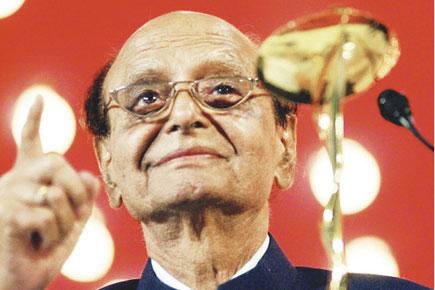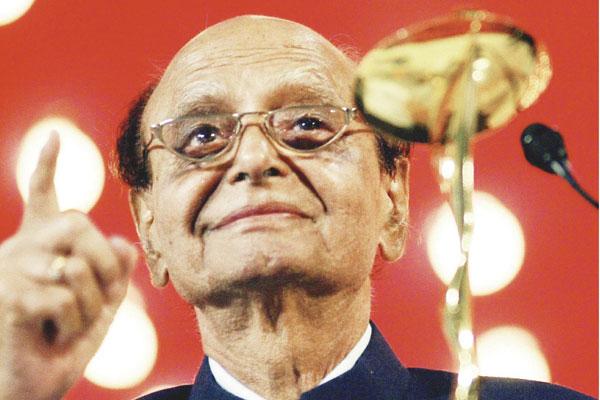On the legendary director Ramanand Sagar's birth anniversary, we bring you 15 interesting facts about his life and illustrious career that you may not have known

Ramanand Sagar received the Life Time Achievement Award at Indian Telly Awards in 2004 at Chitrakoot Ground Andheri (W)
For one hour, every Sunday morning at 9.30 am, from January 25, 1987 to July 31, 1988, the streets of India wore a deserted look. Means of public transport – buses and trains – plied empty. Where was everybody?
At any place with a television set to watch this epic saga. To get engaged in religious and cultural awareness. To give a child an opportunity to interact and bond with his family.
The show was 'Ramayan', Indian television's first blockbuster that opened doors to a whole new gamut of mythological shows. The director was Ramanand Sagar, heralded by many as a magician to breathe life into a mythological tale with his wand of art.
ADVERTISEMENT

Ramanand Sagar received the Life Time Achievement Award at Indian Telly Awards in 2004 at Chitrakoot Ground, Andheri (W) in Mumbai. Pic/Ashish Rane
On the legendary director's birth anniversary, we bring you 15 interesting facts about his life and illustrious career that you may not have known.
1) Born Chandramauli Chopra at Asal Guru Ke near Lahore on December 29, 1917, he was adopted by his maternal grandmother who changed his name to Ramanand.
2) His first recorded work dates back to the age of 16, when he wrote a piece of prose-poetry titled 'Pritam Pratiksha' for Shri Pratap College Magazine in Srinagar, Kashmir. His editor was impressed but, in disbelief, wrote a disclaimer: “The editor is not responsible for its originality”.
3) Struggling for a living, he did many odd jobs such as working as a peon, truck-cleaner, soap-vendor etc. during the day and studied for his degree at night.
4) From a reporter to sub-editor of 'Daily Milap' and 'Daily Pratap' in Lahore, he rose to be the news editor for 'Daily Milap'.
5) While practicing journalism, he continued to pen prose, poetry and stage plays, under names like Ramanand Chopra, Ramanand Bedi and Ramanand Kashmiri.
6) In 1932, he started his film career as a clapper boy in a silent film 'Raiders of the Rail Road'.
7) In 1942, when he was diagnosed with tuberculosis, he wrote a subjective column 'Diary of a T.B. patient' chronicling his fight. The column was published in series in the magazine 'Adab-e-Mashriq' in Lahore and garnered critical acclaim.
8) After India's partition, he shifted to Bombay in 1949. His only possessions were five annas and some manuscripts that expressed the horrors of the partition. These manuscripts formed basis for 'Aur Insaan Mar Gaya', his life's masterpiece. Celebrated as a classic in Urdu and Hindi literature, it was translated into several Indian and foreign languages. The English version was titled 'And Humanity Died'.
9) He made his foray into the Hindi film industry in 1949 by penning dialogues and writing screenplay for Raj Kapoor's hit film 'Barsaat'.
10) He founded his production company 'Sagar Art Corporation' in 1950 which has 25 Hindi movies to its credit, including blockbusters such as 'Ghunghat', 'Paigham', 'Ankhen', 'Geet', 'Baghavat', 'Lalkar', 'Kohinoor', 'Zindagi' and 'Arzoo' to name a few.
11) While shooting for 'Charas' in France in the '70s, Ramanand Sagar visited a French home and joined the family in watching television together. This triggered a visionary thought that TV will ultimately surpass the big screen. In line with this belief, Ramanand Sagar and his sons entered television production in 1985, making 'Vikram Aur Betaal', 'Ramayan', 'Shri Krishna', 'Luv Kush' and 'Alif Laila', among other notable shows, over the years. His last known work was TV show 'Sai Baba' in 2005.
12) 'Ramayan' was initially rejected by Doordarshan due to a perceived lack of interest in religious programming. However, it went on to become one of the most popular shows in Indian television history. It held a Limca Record for the 'World's Most Viewed Mythological Serial' until June 2003.
13) He won two Filmfare awards, while being nominated for three others. He was honoured with the title Sahitya Vachaspati (Doctor of Literature) by the Hindi Sahitya Sammelan and was also awarded the Padma Shri by the government.
14) He was the step-brother of Indian filmmaker Vidhu Vinod Chopra's father, DN Chopra.
15) His son, Sagar, used to fondly call him 'the pauper prince turned emperor'.
 Subscribe today by clicking the link and stay updated with the latest news!" Click here!
Subscribe today by clicking the link and stay updated with the latest news!" Click here!






